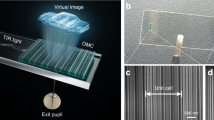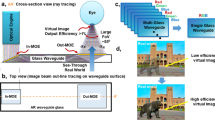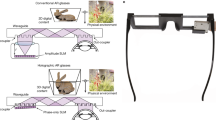Abstract
An ideal waveguide display for augmented reality would feature a single-layer waveguide substrate combined with dispersion-free couplers. While metasurfaces have been explored as a potential solution for waveguide displays, severe limitations—such as low efficiency, poor uniformity and chromatic aberration—remain unresolved. Here we introduce a single-layer waveguide display using achromatic metagratings. The proposed metagratings comprise periodic arrays of rectangular nanostructures, diffracting red, green and blue lights in the same direction. Therefore, they ensure an achromatic propagation angle within the single waveguide substrate maintaining high-quality projected images. As a proof of concept, we demonstrate a full-colour augmented reality waveguide display with a 500-μm-thick single-layer waveguide substrate that substantially reduces the device form factor and weight while enhancing brightness and colour uniformity with a sufficient eyebox. This approach overcomes the limitations of traditional augmented reality near-eye optical designs, which rely on multi-layer grating couplers that require complex fabrication processes and are too heavy for ergonomic head-mounted applications.
This is a preview of subscription content, access via your institution
Access options
Access Nature and 54 other Nature Portfolio journals
Get Nature+, our best-value online-access subscription
$32.99 / 30 days
cancel any time
Subscribe to this journal
Receive 12 print issues and online access
$259.00 per year
only $21.58 per issue
Buy this article
- Purchase on SpringerLink
- Instant access to full article PDF
Prices may be subject to local taxes which are calculated during checkout





Similar content being viewed by others
Data availability
The data that support the findings of this study are available from the corresponding author upon request. All data are available in the main text or Supplementary Information. Source data are provided with this paper.
References
Kress, B. & Starner, T. A review of head-mounted displays (HMD) technologies and applications for consumer electronics. Photonic Appl. Aerosp. Commer. Harsh Environ. 8720, 62–74 (2013).
Olsson, M. I. Wearable device with input and output structures. US patent 20,130,044,042 (2011).
Zheng, Z., Liu, X., Li, H. & Xu, L. Design and fabrication of an off-axis see-through head-mounted display with an x-y polynomial surface. Appl. Opt. 49, 3661–3668 (2010).
Wei, L., Li, Y., Jing, J., Feng, L. & Zhou, J. Design and fabrication of a compact off-axis see-through head-mounted display using a freeform surface. Opt. Express 26, 8550–8565 (2018).
Wu, J. Y. & Kim, J. Prescription AR: a fully-customized prescription-embedded augmented reality display. Opt. Express 28, 6225–6241 (2020).
Huang, H. & Hua, H. High-performance integral-imaging-based light field augmented reality display using freeform optics. Opt. Express 26, 17578–17590 (2018).
Maimone, A., Georgiou, A. & Kollin, J. S. Holographic near-eye displays for virtual and augmented reality. ACM Trans. Graph. 36, 85 (2017).
Jang, C. et al. Retinal 3D: augmented reality near-eye display via pupil-tracked light field projection on retina. ACM Trans. Graph. 36, 190 (2017).
Kim, S. B. & Park, J. H. Optical see-through Maxwellian near-to-eye display with an enlarged eyebox. Opt. Lett. 43, 767–770 (2018).
Maimone, A. et al. Pinlight displays: wide field of view augmented reality eyeglasses using defocused point light sources. ACM Trans. Graph. 33, 89 (2014).
Jeong, J. et al. Holographically printed freeform mirror array for augmented reality near-eye display. IEEE Photonics Technol. Lett. 32, 991–994 (2020).
Lee, B., Jo, Y., Yoo, D. & Lee, J. Recent progresses of near-eye display for AR and VR. In Multimodal Sensing and Artificial Intelligence: Technologies and Applications II (ed. Stella, E.) vol. 11785, 1178503. International Society for Optics and Photonics (SPIE, 2021).
Kress, B. C. Optical Architectures for Augmented-, Virtual-, and Mixed-Reality Headsets (Society of Photo-Optical Instrumentation Engineers, 2020).
Levola, T. 7.1: Invited paper: novel diffractive optical components for near to eye displays. In SID Symposium Digest of Technical Papers, vol. 37, 64–67 (Wiley Online Library, 2006).
Kress, B. C. & Chatterjee, I. Waveguide combiners for mixed reality headsets: a nanophotonics design perspective. Nanophotonics 10, 41–74 (2021).
Amitai, Y. Substrate-guided optical devices. US patent 7,672,055 (2010).
Ding, Y. et al. Waveguide-based augmented reality displays: perspectives and challenges. eLight 3, 24 (2023).
Cheng, D., Wang, Y., Xu, C., Song, W. & Jin, G. Design of an ultra-thin near-eye display with geometrical waveguide and freeform optics. Opt. Express 22, 20705–20719 (2014).
Xu, M. & Hua, H. Methods of optimizing and evaluating geometrical light guides with microstructure mirrors for augmented reality displays. Opt. Express 27, 5523–5543 (2019).
Äyräs, P., Saarikko, P. & Levola, T. Exit pupil expander with a large field of view based on diffractive optics. J. Soc. Inf. Disp. 17, 659–664 (2009).
Yeoh, I. L. Wavelength multiplexing in waveguides. US patent 0,329,075 (2017).
Saarikko, P. Waveguide. US patent 0,231,568 (2016).
Yang, Q., Ding, Y. & Wu, S. T. Full-color, wide field-of-view single-layer waveguide for augmented reality displays. J. Soc. Inf. Disp. 32, 247–254 (2024).
Ding, Y., Li, Y., Yang, Q. & Wu, S. T. Design optimization of polarization volume gratings for full-color waveguide-based augmented reality displays. J. Soc. Inf. Disp. 31, 380–386 (2023).
Gu, Y. et al. A study of the field of view performance for full-color waveguide displays based on polarization volume gratings. Crystals 12, 1805 (2022).
Guo, Q., Zhang, S., Zhang, J. & Chen, C. P. Design of single-layer color echelle grating optical waveguide for augmented-reality display. Opt. Express 31, 3954–3969 (2023).
Gopakumar, M. et al. Full-colour 3D holographic augmented-reality displays with metasurface waveguides. Nature 629, 791–797 (2024).
Deng, Z. L., Zhang, S. & Wang, G. P. Wide-angled off-axis achromatic metasurfaces for visible light. Opt. Express 24, 23118–23128 (2016).
Huang, L. et al. Dispersionless phase discontinuities for controlling light propagation. Nano Lett. 12, 5750–5755 (2012).
Escuti, M. J., Kim, J. & Kudenov, M. W. Controlling light with geometric-phase holograms. Opt. Photonics News 27, 22–29 (2016).
Luo, W., Xiao, S., He, Q., Sun, S. & Zhou, L. Photonic spin Hall effect with nearly 100% efficiency. Adv. Opt. Mater. 3, 1102–1108 (2015).
Song, N. et al. Broadband achromatic metasurfaces for longwave infrared applications. Nanomaterials 11, 2760 (2021).
Devlin, R. C., Khorasaninejad, M., Chen, W. T., Oh, J. & Capasso, F. Broadband high-efficiency dielectric metasurfaces for the visible spectrum. Proc. Natl Acad. Sci. USA 113, 10473–10478 (2016).
Hecht, E. in Optics Ch. 4 (Pearson Edu. Press, 2017).
Azzam, R. M. A. Circular and near-circular polarization states of evanescent monochromatic light fields in total internal reflection. Appl. Opt. 50, 6272–6276 (2011).
Xiong, J. & Wu, S. T. Planar liquid crystal polarization optics for augmented reality and virtual reality: from fundamentals to applications. eLight 1, 3 (2021).
Chen, W. T. et al. Dispersion-engineered metasurfaces reaching broadband 90% relative diffraction efficiency. Nat. Commun. 14, 2544 (2023).
Kim, S., Kim, J., Kim, K., Jeong, M. & Rho, J. Anti-aliased metasurfaces beyond the Nyquist limit. Nat. Commun. 16, 411 (2025).
Brown, R. D. Transparent waveguide display. EP patent 2,733,517 (2014).
Grey, D. Exit pupil expanding diffractive optical waveguide device. US patent 10,359,635 (2019).
Cheng, D. et al. Design and manufacture AR head-mounted displays: a review and outlook. Light Adv. Manuf. 2, 350–369 (2021).
Liu, S. et al. Waveguide using grating coupler for uniform luminance and color AR display. In Optical Design and Testing X, vol. 11548, 74–80 (SPIE, 2022).
Ni, D. et al. Uniformity improvement of two-dimensional surface relief grating waveguide display using particle swarm optimization. Opt. Express 30, 24523–24543 (2022).
Wall, R. A. Waveguide-based displays with exit pupil expander. US patent 10,025,093 (2017).
Abovitz, R. Planar waveguide apparatus with diffraction element(s) and system employing same. US patent 9,671,566 (2015).
Maikisch, J. S. & Gaylord, T. K. Optimum parallel-face slanted surface-relief gratings. Appl. Opt. 46, 3674–3681 (2007).
Jin, G. et al. High efficiency polarization-independent slanted grating for RGB bands. IEEE Photonics J. 13, 1–8 (2021).
Levola, T. Diffractive optics for virtual reality displays. J. Soc. Inf. Disp. 14, 467–475 (2006).
Liu, Y. et al. Slanted TiO2 metagratings for large-angle, high-efficiency anomalous refraction in the visible. Laser Photonics Rev. 17, 2200712 (2023).
Li, T., Cao, L., He, Q. & Jin, G. Slanted volume holographic gratings design based on rigorous coupled-wave analysis. In Holography, Diffractive Optics, and Applications V, vol. 8556, 105–112 (SPIE, 2012).
Kim, J. et al. Scalable manufacturing of high-index atomic layer–polymer hybrid metasurfaces for metaphotonics in the visible. Nat. Mater. 22, 474–481 (2023).
Kim, J. et al. A water-soluble label for food products prevents packaging waste and counterfeiting. Nat. Food 5, 293–300 (2024).
Kim, J. et al. Amorphous to crystalline transition in nanoimprinted sol–gel titanium oxide metasurfaces. Adv. Mater. 37, 2405378 (2025).
Kim, J. et al. Wafer-scale, centimeter-sized, high-efficiency metalenses in the ultraviolet. Mater. Today 73, 9–15 (2024).
Kim, J. et al. One-step printable platform for high-efficiency metasurfaces down to the deep-ultraviolet region. Light Sci. Appl. 12, 68 (2023).
Choi, M. et al. Roll-to-plate printable RGB achromatic metalens for wide-field-of-view holographic near-eye displays. Nat. Mater. 24, 535–543 (2025).
Acknowledgements
This work was financially supported by the POSCO-POSTECH-RIST Convergence Research Center programme funded by POSCO, an industry-academia strategic grant funded by Samsung Research, the Samsung Research Funding and Incubation Center for Future Technology grant (SRFC-IT1901-52) funded by Samsung Electronics, the Korea Planning and Evaluation Institute of Industrial Technology (KEIT) grant (no. 1415179744/20019169, Alchemist project) funded by the Ministry of Trade, Industry and Energy (MOTIE) of the Korean government and the National Research Foundation (NRF) grants (RS-2024-00356928, RS-2024-00462912, RS-2024-00416272, RS-2024-00337012, RS-2024-00408286, RS-2022-NR067559 and RS-2022-NR068141) funded by the Ministry of Science and ICT (MSIT) of the Korean government. J.K. acknowledges the Asan Foundation Biomedical Science fellowship, and the Presidential Science fellowship funded by the MSIT of the Korean government.
Author information
Authors and Affiliations
Contributions
J.R. conceived the idea and initiated the project. J.R., S.M., S.K., J.K. and C.-K.L. did theoretical studies and designed the whole experiments. S.M. and S.K. performed the numerical simulations and optimizations of the metagratings and the waveguide AR display architecture. J.K. fabricated the metagratings. S.M., S.K. and J.K. performed the experimental characterizations and data analyses of the metagratings. S.M. and C.-K.L. performed the experimental characterizations and data analyses of the waveguide AR display prototype. S.M., S.K., J.K. and J.R. mainly wrote the paper. All authors confirmed the final paper. J.R. guided the entire work.
Corresponding author
Ethics declarations
Competing interests
The authors declare that a Korean patent application (10-2024-0037912) is related to the technology described in this study. This patent, titled ‘Waveguide and electronic device employing the same’, is invented by the authors of this paper and co-owned by Samsung Electronics and POSTECH. Although not referenced directly in the paper, it was presented as evidence during the review process to confirm the originality of the work.
Peer review
Peer review information
Nature Nanotechnology thanks Chao Ping Chen, Wei Ting Chen and the other, anonymous, reviewer(s) for their contribution to the peer review of this work.
Additional information
Publisher’s note Springer Nature remains neutral with regard to jurisdictional claims in published maps and institutional affiliations.
Extended data
Extended Data Fig. 1 Optical characteristics of AMG.
a, Measured AR scene transmittance of out-coupler AMG. For the measurement, a white LED light source (Doric, Cled white 5500 K) and a spectroradiometer (Konica Minolta, CS-2000) are used. The average transparency of AMG across the entire visible wavelength range is 67%. Scattering from the AMG atoms and Fresnel reflections at the substrate surface lower the transparency. b, Wavelength bandwidth of in-coupler AMG for 4th, 5th and 6th order. c, Diffraction efficiency of in-coupler AMG for 4th, 5th, and 6th order according to different grating heights. The in-coupler AMG achieves both a perfect RGB achromatic profile and the highest average efficiency when the grating height is 250 nm.
Extended Data Fig. 2 Angular bandwidth of in-coupler AMG.
a, Experiment setup for measuring angular bandwidth of in-coupler AMG. A power meter (Newport; Model 2936-R), a 4-axis rotation stage (Sigma Koki; Shot-304GS) and three different light sources with designed wavelengths of 658 nm (Cobolt; Flamenco-300), 526 nm (WikiOptics; Venus) and 439 nm (WikiOptics; Venus combined with Edmund; 440 nm CWL Hard Coated Bandpass Filter) are adopted. To measure the intensity of desired diffraction orders, a triangular shape prism is attached to the substrate using OCA film to break the TIR condition. b, c, d, The measured efficiency of the 4th, 5th, and 6th orders for the R, G, and B. It exceeds 70% of the theoretical values (658 nm: 18.8%, 526 nm: 17.9%, 439 nm: 19.6%). The loss results from scattering and absorption in the meta-atoms as well as fabrication errors. The maximum FOV is defined where the diffraction efficiency drops to 10%. Here, the threshold value of the FOV is determined by a y-axis angular bandwidth of 658 nm.
Supplementary information
Supplementary Information
Supplementary Notes 1–6, Figs. 1–6, Table 1 and References 1–3.
Source data
Source Data Fig. 2
Diffraction efficiencies for metagrating.
Source Data Extended Data Fig./Table 1
Diffraction efficiencies with respect to the height of metagrating.
Source Data Extended Data Fig./Table 2
Measured and calculated angular bandwidth of metagrating.
Rights and permissions
Springer Nature or its licensor (e.g. a society or other partner) holds exclusive rights to this article under a publishing agreement with the author(s) or other rightsholder(s); author self-archiving of the accepted manuscript version of this article is solely governed by the terms of such publishing agreement and applicable law.
About this article
Cite this article
Moon, S., Kim, S., Kim, J. et al. Single-layer waveguide displays using achromatic metagratings for full-colour augmented reality. Nat. Nanotechnol. 20, 747–754 (2025). https://doi.org/10.1038/s41565-025-01887-3
Received:
Accepted:
Published:
Issue date:
DOI: https://doi.org/10.1038/s41565-025-01887-3
This article is cited by
-
Electronics and photonics-related research and education at POSTECH
Nature Reviews Electrical Engineering (2025)
-
Compact eye camera with two-third wavelength phase-delay metalens
Nature Communications (2025)
-
Extended reality technologies for applications in the metaverse
Nature Reviews Electrical Engineering (2025)



